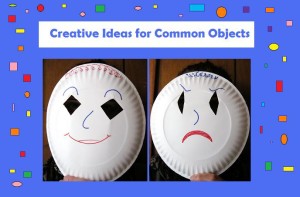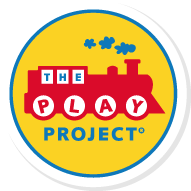 By: Ashley Case, OT, Robin Vettraino, OT
By: Ashley Case, OT, Robin Vettraino, OT
In honor of PLAY and finding fun things to do regardless of where you are or what you have access to, we have created a list of ideas that kids and adults can enjoy together. The items you’ll see listed below are not traditional toys, and at first glance, may not seem like things you would use for PLAY. However, we put our heads together and came up with fun and creative ways to use these common household objects for PLAY. We’d love to hear about the creative ways you and your family use common household items for PLAY!
Paper plate
- Frisbee: try to throw it back and forth like a Frisbee – motor planning
- Mask: cut out 2 holes for eyes and draw happy, sad, or silly faces on the front and hold it over your face – visual, pretend
- Shield: use as a shield for your paper towel roll sword – pretend
- Lily pads: lie several plates in a path on the floor and hop from one to the other – pretend, gross motor coordination
- Tambourine: staple 2 plates together with dry beans or rice in the middle. Shake to music – fine motor, auditory
- Paper Shoes: stand on paper plates and slide across wood floor or tile – proprioception, motor planning
Paper towel roll
- Eye spy: when spying for the object, use the paper towel roll like binoculars or a telescope – visual, cognitive
- Telephone: whisper silly phrases to each other through the paper towel roll- auditory, cognitive
- Sword fighting: use the paper towel roll as a sword- motor planning, gross motor coordination, pretend
- Noise maker: tape one end closed and fill half way with rice or beans, then tape the other end closed and shake- motor planning, auditory
- Paper People: use paper towel rolls for arms and legs, paper plate for head and body. Tie together with pipe cleaner, color and decorate – sequencing, fine motor, cognitive
- Bracelets: cut into smaller pieces and make bracelets. You can decorate them with markers, beads, or glitter – motor planning, pretend, fine motor
- Stamp: dip one end in paint and use as a ‘circle stamp’ on paper – visual, motor planning
Empty box
- Drum: flip the box over and pound on it with your hands or with sticks – proprioception, motor planning, auditory
- Driving: pretend it’s a car and push it around or get in it and pretend to drive it –motor planning, pretend
- Knock-knock game: draw some squares for windows and a rectangle for a door and pretend it’s a house or cut out the windows/door – motor planning, pretend
- Bean bag toss or basketball: try tossing various items, such as bean bags or plastic balls, into the box from a short distance – motor planning, gross motor coordination
- Mailbox: cut a slot in the box and parent/child can be mailman and deliver mail. Child/parent can write real or pretend letters – pretend, fine motor, cognitive
- Dog house: draw paw prints all over the box and cut some holds in the sides. Place stuffed animals inside or invite your dog to sit in the house with you – pretend, fine motor
Empty water/pop bottles
- Stacking: take turns stacking them on top of each other and see how many you get until they topple over – visual, motor planning
- Bowling: line up empty bottles and roll a ball into them – motor planning, cognitive, visual
- Fill and Pour: fill with water, rice, sand, etc. and pour into different containers or on hands/feet – fine motor, tactile
- Drumming: use bottles as “drum sticks”. Imitate rhythm, drum to music, drum different places to hear different noise – auditory, pretend
- Noise makers: fill with rice or dry beans and shake! Listen to the different sounds various fillers make – auditory, motor planning
- I spy: fill with rice and add tiny items (beads, coins, pebbles) and then shake it up and try to find all of the ‘hidden items’– fine motor, visual
- Volcano: put a little baking soda in the bottle and then some vinegar until it starts to fizz and bubble up (do this outside or over the sink). You could even put small plastic characters in the bottle to see if they are pushed out by the volcano – visual, pretend
- Vase: decorate a piece of paper and tape or glue it onto an empty bottle. Then pick some wild flowers and put them inside with some water- fine motor
Blanket/sheet
- Tug-o-war: sit or stand across from each other and tug back and forth –proprioception, motor planning
- Parachute: with 2-6 people, hold a section of the blanket and float it up into the air and back down –visual, motor planning
- Blanket ride: fold the blanket in half and sit on one end while another person pulls it – proprioception, gross motor
- Ghost: put the sheet over your head and make a Oooo sound as you walk around the room – pretend, visual
- Cocoon: roll someone up in the blanket (with their face uncovered) –proprioception, self regulation
- Fort: drape over a table or other furniture to create a small hideaway and pretend you are in a cave, underwater, etc. – pretend
- Hammock: have child lie in blanket while 2 adults grab the ends and gently swings back and forth – vestibular, self-regulation
Sock
- Make a hand puppet: draw eyes with marker and make the puppet talk, kiss, burp, etc. – pretend play
- Bean bag toss: fill socks up with beans or rice and use it like a bean bag –motor planning, coordination
- Calming aid: fill it up with rice and microwave for 30 seconds (or just until warm) –tactile, self regulation
- Guess what’s inside: Put small items inside sock and have child feel and guess what is inside, take turns guessing! – proprioception, cognitive
- Mini garden: fill a sock with top soil, tie a knot in the end, cut small holes in the top and push 1 seed into each hole. May work best with herbs, small flowers or other small plants. Place outside in the sun or on a window sill in a plastic container and water daily -sensory, cognitive, sequencing
Glossary:
Sensory: Engaging one or more of the 8 senses (auditory, visual, olfactory, gustatory, touch, proprioceptive, vestibular, interoception)
Vestibular: The ability to detect changes in head position related to balance and knowing where your body is in space, etc.
Proprioception: Input to and awareness of position of joints, muscles, and tendons related to the amount of effort needed to move, play, etc.
Sequencing: The ability to complete a task or activity involving 2 or more steps
Self regulation: A child’s ability to calm oneself after a period of distress, excitement, etc.
For more definitions or information about the sensory systems, visit: Sensory Therapies and Research Center
